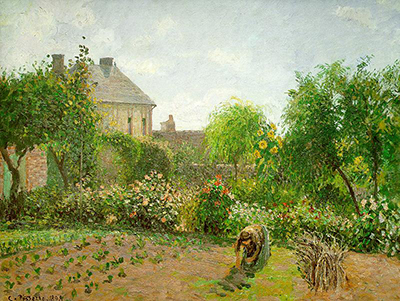The Artist's Garden at Eragny was done in 1898 by Camille Pissarro. The portrait shows a painting done with a lot of precision especially on how light and colours contrast each other naturally. The piece shows a young peasant woman doing some gardening.
The garden is full of different plants and flowers. There are also some trees surrounding the garden. At the corner of the garden, a house and a wall are visible. From the sky, one can also see the white and blue clouds. Pissarro took his art classes at Paris's Art Academies. However, he did not like the approach used by the school. He, therefore, became an admirer of Jean Baptiste Camille Corot who was painting landscapes freely and using a different style. It is then that he decided to become a student of Corot. It is no wonder then that most of Pissarro's paintings reflect the influence of Corot.
Unlike his Impressionist painters who made portraits of the city, he opted to showcase the rural life led by peasants. In his paintings, Camille used the technique of light on colour to make his work more spontaneous. At one point he went to study art in Caracas where he learnt about nature, light, and colour which to a large extent contributed to his artistic themes. Gustave Courbet also inspired Camille's work and it is evident that Camille borrowed from his colleague Gustave who was a Realist. It is no wonder, therefore, that the two painters had similar thoughts especially on how they tried to glorify peasants, their hard labour, and communal activities back in the villages. Pissarro combined the techniques of Impressionism and those of Realism in his paintings especially on Artist's Garden at Eragny.
Pissarro Camille used oil on canvas for all his paintings. He was also among the few artists who blended colour and light to produce harmonious portraits. Besides, since he lived most of his life in the French villages, he appreciated nature in his works. He thus ensured to portray the terrains in which the peasants worked from which is clearly visible from most of his artworks including Artist's Garden at Eragny.
Camille believed that it was impossible to showcase a painting without having to use light. Other than most of his paintings being about rural peasant life, he also made portraits about city life. At times Camille also expressed his radical political views through his paintings. His spontaneity led to a lot of criticism about his work. However, Camille coached many young men who later became notable in the art world such as Paul Cézanne and Paul Gauguin.
The Artist's Garden at Eragny painting was left with Pissarro's family upon his death and was later taken by the Mellon family. Later, the piece was donated to the museum for public access. Eventually, his work was accepted and Camille became one of the artists who linked old and rigid art to modern art.




